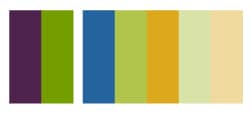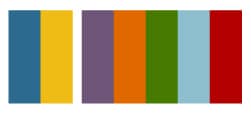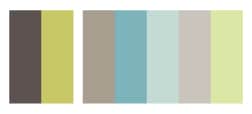“How do you create your color palettes?” I’ve been asked that quite a few times over the years. Sometimes to create a successful color palette I seem to rely on intuition, but that’s only because after years of creating color families some things become second nature.
There are some basic rules to follow when getting started. Using the basic rules as a structure, there is then a certain amount of freedom to explore color combinations. This is the point where, yes, I rely a little on intuition. This is also the fun part. Telling a color story.
First, we should ask why color is so important. Well, color can strongly affect your brand recognition–reportedly increasing it as much as 80%. It’s also been stated that up to 60% of people decide if they like a message based on color. So color is very important, and which colors are chosen can be important.
Knowing a bit of color psychology is helpful when getting started with designing a color family. In general it’s easier designing when there are some rules, and color associations provide those rules. For example, green is the color of nature. It symbolizes growth, freshness, serenity, and healing. Blue is perceived as trustworthy, loyal, dependable, and serene. It’s also the color of the sky and water. Because of this, you will often see these two colors used together in branding for environmental related organizations, especially for those that deal with both land and water or land and air. Orange typically brings feelings of energy, creativity, warmth, enthusiasm, and stimulation. It is also often paired with blue, especially when communicating a clean energy message. Orange, yellow, and red are also known to stimulate the appetite, which is often why you see these colors in food packaging and in restaurants. Some color associations are best not to ignore or play with unless you have a solid strategy behind it.
Making color choices requires some deeper knowledge about the organization or business and their current audience. Or the audience they would like to reach.
Deciding which shade of blue and which shade of green and how they interact—that’s where the creativity and the fun take place. Making these choices requires some deeper knowledge about the organization or business and their current audience. Or the audience they would like to reach. An older, more traditional audience might not be as attracted to a vibrant lime green as a younger audience might. If the organization is very innovative, a brighter blue might be more appropriate. Throwing in an unexpected color is another way an innovative company could visually express part of their message. The degree to which brand colors depart from rules depends a lot on the comfort level of the organization and the audience they are trying to reach.
No one wants to sign off on a logo that looks beautiful in full color, only to find out they can’t afford to have it embroidered on their company shirts.
Another rule that guides my color choices when developing brand colors is sticking to 2-3 main colors. These are used in the logo, and a handful of secondary colors are added as necessary. Sometimes secondary colors are needed as background colors or ways of defining different areas of a website. Sometimes they can help soften a logo with intense colors when it’s needed. Logos should be simple, clean, and easily reproduced at any size. They should also have the ability to be reproduced in grayscale or one color. Keeping the number of colors to a minimum works hand in hand with this. It can also keep production costs reasonable. No one wants to sign off on a logo that looks beautiful in full color, only to find out they can’t afford to have it embroidered on their company shirts. Or that it doesn’t work well printed in one color. For this reason when I’m creating color palettes I’m always thinking ahead to how the colors will be reproduced.
Designing color families is one of my favorite parts of this job. It can be a wonderfully collaborate process with clients. It’s a chance to not only see how colors interact with each other, but to see how they can add to or change a message. Often they can transform a design. “How do you create your color palettes?” A few rules, and years of experience.



